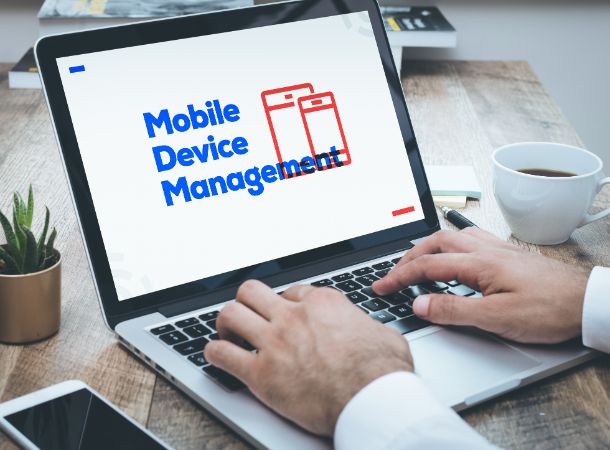Mobile device management (MDM) is a software solution that enables organizations to manage and secure their mobile devices, such as smartphones, tablets, and laptops, from a centralized platform. MDM is typically used in corporate environments where employees use mobile devices for work-related tasks and need to access sensitive data or company resources.
MDM solutions provide administrators with a range of features that allow organizations to manage the devices, including:
Device enrolment: Administrators can enroll new devices into the MDM system and assign them to users.
Device configuration: Administrators can configure the devices with specific settings, such as email, Wi-Fi, and VPN configurations, as well as push updates and patches.
Application management: Administrators can manage the applications installed on the devices, control access to specific applications, and push updates and patches.
Security management: Administrators can enforce security policies on the devices, such as password policies, encryption, and remote wipe capabilities.
Monitoring and reporting: Administrators can monitor device usage, track location, and generate reports on device performance, compliance, and security.
MDM solutions are essential for ensuring the security and compliance of mobile devices in corporate environments. They help organizations to reduce the risk of data breaches, maintain regulatory compliance, and improve the productivity and efficiency of their mobile workforce.
Why is mobile device management critical?
Mobile device management (MDM) is essential for several reasons, including:
Security: Mobile devices are vulnerable to security threats, such as malware, phishing attacks, and data breaches. MDM solutions help organizations to secure their mobile devices by enforcing security policies, such as password requirements, data encryption, and remote wipe capabilities.
Compliance: Many industries have regulatory requirements for data privacy and security. MDM solutions can help organizations to meet these requirements by monitoring and reporting on device usage, enforcing security policies, and controlling access to sensitive data.
Productivity: Mobile devices have become essential tools for many employees, enabling them to work remotely and access corporate resources. MDM solutions can help organizations improve their mobile workforce’s productivity by configuring devices correctly and ensuring applications are up-to-date and data is secure.
Cost savings: Managing mobile devices can be a time-consuming and resource-intensive task. MDM solutions can help organizations to reduce the cost of managing mobile devices by automating tasks such as device configuration, application management, and security updates.
In summary, mobile device management is vital for organizations to ensure their mobile devices’ security, compliance, productivity, and cost-effectiveness. Without MDM, organizations may be vulnerable to security threats, non-compliance with regulations, reduced productivity, and increased costs.
How mobile device management works?
Mobile device management (MDM) uses software to manage and control mobile devices from a centralized platform. Here’s a general overview of how MDM works:
Device enrolment: The first step in using MDM is to enroll mobile devices into the MDM system. Enrollment involves installing an MDM agent or profile on the device, which allows it to communicate with the MDM server.
Device configuration: Once enrolled in the MDM system, administrators can configure the device with specific settings, such as email, Wi-Fi, and VPN. Administrators can also push updates and patches to devices to ensure they are up-to-date and secure.
Application management: MDM solutions allow administrators to manage the applications installed on the devices. They can push new applications to devices, control access to specific applications, and push updates and patches.
Security management: MDM solutions can help organizations enforce security policies on the devices, such as password policies, data encryption, and remote wipe capabilities. If a device is lost or stolen, administrators can remotely wipe the device to ensure that sensitive data is not compromised.
Monitoring and reporting: MDM solutions provide administrators with various monitoring and reporting tools. They can monitor device usage, track location, and generate reports on device performance, compliance, and security.
MDM solutions use a variety of technologies to manage and control mobile devices. These include mobile device management protocols (such as Apple’s Device Enrollment Program and Android Enterprise), device management APIs (such as Apple’s Mobile Device Management API and Google’s Android Management API), and mobile application management frameworks (such as Microsoft’s Intune and VMware’s Workspace ONE).
Mobile device management (MDM) tools typically consist of several components that work together to manage and secure mobile devices. These components include:
MDM server: This is the core component of the MDM solution. The MDM server manages and controls mobile devices, enforces security policies, and pushes updates and patches.
MDM agent: The MDM agent is a software application installed on mobile devices. It communicates with the MDM server and allows administrators to manage the device remotely.
Enrolment portal: This web-based portal allows users to enroll their mobile devices into the MDM system. The enrolment portal typically provides instructions on installing the MDM agent and configuring the device.
Device management console: This web-based interface allows administrators to manage and control mobile devices from a centralized location. The device management console provides a range of features, such as device configuration, application management, and security management.
Application management: MDM solutions include features for managing applications on mobile devices. MDM management includes pushing new applications to devices, controlling access to certain applications, and pushing updates and patches.
Security management: MDM solutions help organizations enforce mobile device security policies. Security management includes password policies, data encryption, and remote wipe capabilities.
Reporting and analytics: MDM solutions provide administrators with various reporting and analytics tools. The Reporting and Analytics include monitoring device usage, tracking location, and generating reports on device performance, compliance, and security.
In summary, mobile device management tools typically consist of a server, agent, enrolment portal, device management console, application management, security management, and reporting and analytics features. These components help organizations manage and secure their mobile devices from a centralized platform.
BYOD and mobile device management
BYOD (Bring Your Own Device) is a workplace policy that allows employees to use their personal mobile devices (such as smartphones and tablets) for work purposes. Mobile device management (MDM) is a crucial component of BYOD because it helps organizations manage and secure employees’ mobile devices.
Here are some ways that BYOD and MDM work together:
Device enrolment: With BYOD, employees are responsible for enrolling their personal devices into the MDM system. Enrollment typically involves installing an MDM agent or profile on the device and configuring it with the necessary settings and security policies.
Device management: Once a device is enrolled in the MDM system, administrators can manage and control it remotely. This includes configuring email, Wi-Fi, and VPN settings, pushing updates and patches, and enforcing security policies.
Application management: MDM solutions allow administrators to manage the applications installed on employee devices. They can push new applications to devices, control access to specific applications, and push updates and patches.
Security management: MDM solutions can help organizations to enforce security policies on employee devices, such as password policies, data encryption, and remote wipe capabilities. This helps to protect sensitive corporate data and prevent security breaches.
Employee privacy: One of the challenges of BYOD is balancing the organization’s security needs with employees’ privacy concerns. MDM solutions can help to address this challenge by implementing policies that protect corporate data without compromising employee privacy. For example, administrators can configure devices to separate work and personal data and restrict access to corporate data outside of work hours.
In summary, BYOD and MDM are closely related because MDM solutions are essential for managing and securing personal devices used by employees for work purposes. By implementing MDM policies and procedures, organizations can protect corporate data while allowing employees to use their preferred mobile devices.
Mobile device management best practices
Here are some best practices for mobile device management (MDM):
Develop a mobile device policy: Before implementing MDM, it’s essential to develop a comprehensive policy that outlines how mobile devices will be used in the organization. This policy should cover device security, acceptable use, and employee privacy.
Use secure enrolment methods: When enrolling devices in the MDM system, use secure enrolment methods that require strong passwords and two-factor authentication to ensure that only authorized users can access the system.
Implement robust security policies: Use MDM to enforce strong security policies on mobile devices, such as requiring device encryption, setting passcode requirements, and implementing remote wipe capabilities.
Regularly update devices: Regularly push updates and patches to mobile devices to ensure they are up-to-date and secure. Updates include operating system updates and updates to applications and other software.
Monitor device usage: Use MDM to monitor device usage and identify any security or compliance issues. This includes tracking device location, monitoring data usage, and identifying unauthorized corporate data access.
Train employees: Train employees on how to use their mobile devices securely and comply with the organization’s mobile device policy.
Implement a BYOD program: Consider implementing a BYOD program that allows employees to use their devices for work purposes but ensure that the devices are enrolled in the MDM system and that the necessary security policies are in place.
Regularly review and update policies: Regularly review and update mobile device policies and procedures to ensure they remain practical and current with the latest security threats and industry best practices.
By following these best practices, organizations can effectively manage and secure their mobile devices and protect corporate data from security breaches and other threats.
Mobile application management (MAM): MAM is a solution that focuses specifically on managing and securing mobile applications rather than entire devices. MAM solutions allow organizations to control access to mobile applications, push updates and patches, and enforce security policies per app.
Mobile content management (MCM): MCM is a solution that focuses on managing and securing the content (such as documents and files) accessed and shared on mobile devices. MCM solutions provide secure file-sharing and collaboration tools, data loss prevention, and encryption capabilities.
Enterprise mobility management (EMM): EMM is a comprehensive solution that includes MDM, MAM, and MCM capabilities. EMM solutions provide a centralized platform for managing all aspects of enterprise mobility, including devices, applications, and content.
Unified endpoint management (UEM): UEM is a solution that extends beyond mobile devices to include all endpoints, including laptops, desktops, and IoT devices. UEM solutions provide a centralized platform for managing and securing all endpoints, with device, application, identity, and access management capabilities.
Mobile threat defense (MTD): MTD is a solution that focuses specifically on protecting mobile devices from security threats, such as malware, phishing attacks, and network vulnerabilities. MTD solutions provide real-time threat detection and response capabilities, mobile app reputation scoring and mobile threat intelligence.
By leveraging these related solutions, organizations can enhance their mobile device management capabilities and better protect their mobile devices, applications, and content from security threats and other risks.
Written by – Mr. Adam Pittman
Share:




Leave A Comment